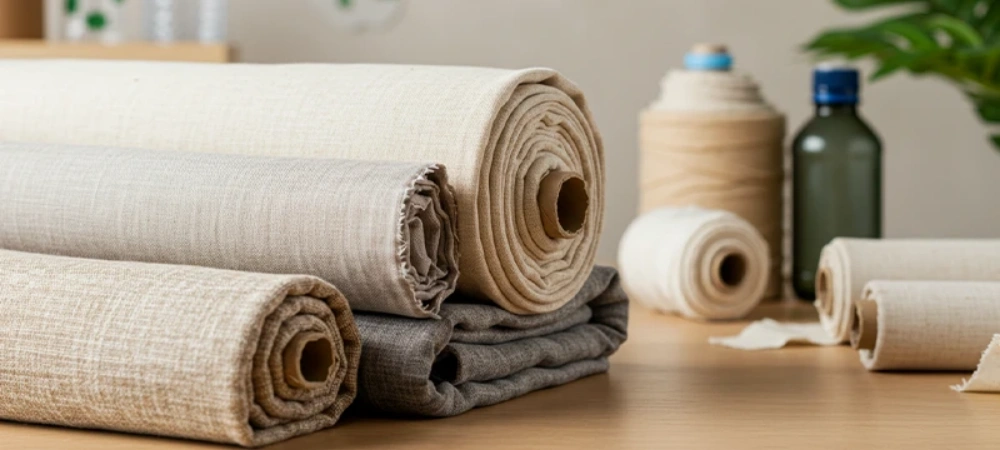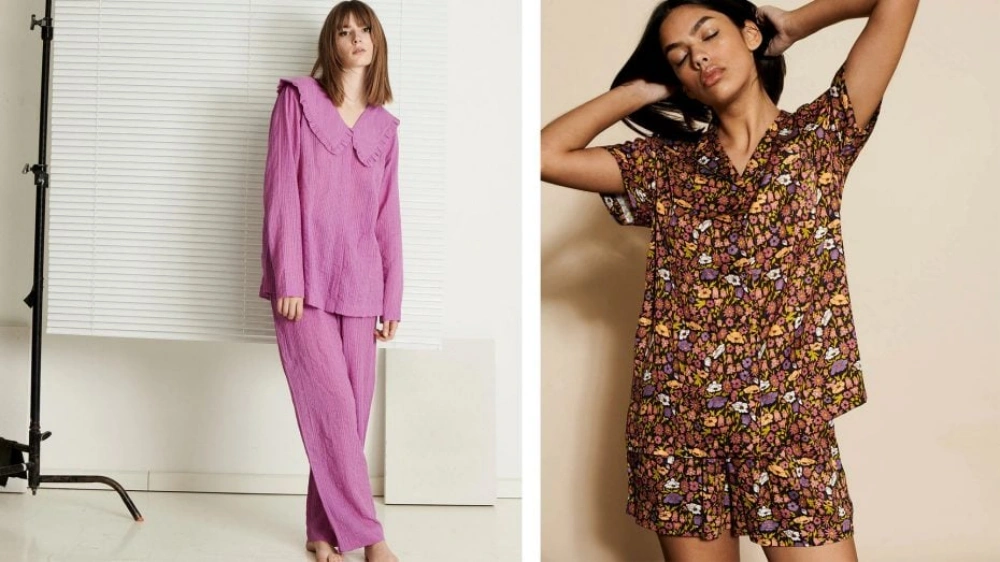You might wonder what recycled fabric is. It’s material made from used textiles, plastic bottles, or other discarded resources. Today, less than 1% of global textile production comes from recycled fabrics, but demand keeps rising.
More people care about the planet, and brands now use recycled materials to make stylish, eco-friendly clothes. Friendtex leads the way with sustainable practices and top-quality designs. The market for recycled fabrics is growing fast, with experts predicting a 14.40% annual increase over the next decade.
Key Takeaways
Recycled fabric is made from used textiles and plastic waste, helping reduce landfill waste and promote sustainability.
Choosing recycled fabrics can save water and energy, with recycled polyester using 59% less energy than virgin polyester.
Look for certifications like GRS and OEKO-TEX to ensure the recycled fabric you buy meets high environmental standards.
Brands like Friendtex lead in using recycled materials, offering stylish and eco-friendly clothing options.
By selecting recycled fabrics, you support a cleaner planet and encourage more brands to adopt sustainable practices.
What is Recycled Fabric?
Definition
You might ask yourself, What is recycled fabric? It’s a material made by turning waste into something new and useful. You see recycled fabrics in clothes, shoes, and even home goods.
Manufacturers use old textiles, plastic bottles, and other discarded items to create these fabrics. Sometimes, they collect marine debris like fishing nets from the ocean and transform it into yarn.
Most recycled fabrics are not made from 100% recycled fibers. You’ll often find blends that mix recycled and virgin fibers. For example, recycled cotton fabrics usually combine recycled cotton with new cotton. Recycled polyester and nylon are also blended with virgin fibers to make them stronger and last longer.
According to the Global Recycled Standard, a yarn needs at least 20% recycled fibers to be called recycled. This blend helps keep the quality high while still reducing waste.
Friendtex takes recycled fabrics seriously. The brand uses advanced technology and follows strict guidelines to make sure every product meets high standards.
Friendtex holds certifications like GOTS, Global Recycled Standard, and many others. These certifications prove that Friendtex uses recycled materials responsibly and cares about the environment.
Did you know? The Global Recycled Standard requires at least 50% recycled content for labels you see in stores. That means you can trust brands with this certification to use real recycled materials.
Here’s a quick look at some important certifications:
Certification Name | Accredited By | Used For | Examples of Brands | Importance |
|---|---|---|---|---|
Global Recycled Standard (GRS) | Textile Exchange | Recycled materials in fashion | Patagonia, Levi’s, TOMS | Verifies use of recycled materials and responsible production practices. Requires a minimum 50% recycled content for consumer-facing labels. |
Recycled Claim Standard (RCS) | Textile Exchange | Recycled materials | Various | Similar to GRS, it focuses on recycled content verification. |
Cradle to Cradle Standard | Cradle to Cradle Products Innovation Institute | Ethical production and end-of-life impact | Various | Rates products from basic to platinum, focusing on material health and sustainability. |
Main Sources
You might wonder where recycled fabrics come from. The answer is simple: manufacturers collect waste from many places and turn it into new products. Here are some main sources of recycled fabric:
Post-consumer waste, like old clothes and used textiles.
Plastic bottles, which are cleaned and melted down to make recycled polyester.
Marine debris, including fishing nets and ocean plastic.
Industrial waste from factories and mills.
Many brands use creative ways to source recycled materials. For example:
Unifi makes graduation gowns from recycled plastic.
Bionic Yarn creates thread from plastic bottles found on coastlines.
Adidas upcycles ocean plastic to design running shoes.
CityPlace installs carpets made from discarded fishing nets.
The method produces soap bottles using recycled plastic.
G-Star RAW launches clothing lines with ocean plastic.
Friendtex uses recycled polyester and organic cotton in its premium fashion lines. The brand’s commitment to recycling and sustainability means you get high-quality products that help protect the planet.
When you choose recycled fabrics, you support a cleaner environment and encourage more brands to use recycled materials.
Making Process
Collection and Sorting
You might wonder how recycled fabrics start their journey. The process begins with collecting used textiles and other recycled materials from places like donation bins and clothing drives. Here’s how it usually works:
Collection: You see materials gathered from homes, stores, and donation centers.
Sorting: Workers separate textiles by type, such as post-consumer or pre-consumer, and by material composition.
Preparation: They check labels for fiber types, clean the textiles, and fold or bag them to keep everything protected.
Grading: Experts decide which items can be resold and which need to be recycled.
Processing: Non-resalable garments get sorted by color and material, shredded into fibers, cleaned, and re-spun into yarn.
Tip: Friendtex uses advanced sorting systems to make sure only high-quality recycled materials go into their recycled fabrics. This helps maintain the durability and comfort you expect from premium products.
Recycling Methods
After sorting, the real transformation begins. You’ll find several recycling methods used to create recycled fabrics, especially recycled polyester. Here are some of the most common techniques:
Chemical, enzymatic, and molecular technologies break down fibers so they can be rebuilt into new recycled fabrics.
Automated detection systems, like color cameras and AI, help sort textile waste quickly and accurately.
Chemical recycling processes turn synthetic fibers into monomers, which are then used to make new recycled polyester.
The Trimclean® system uses metal detection, near-infrared spectroscopy, and smart cameras to boost sorting and recycling efficiency.
Friendtex leads the way by using these advanced recycling methods. The brand’s commitment to sustainable practices is backed by certifications that validate every step of the process.
These certifications set standards for recycled content, require thorough audits, and offer third-party validation so you can trust the recycled fabrics you buy.
Evidence Description | Key Points |
|---|---|
Standards for Recycled Content | Sets clear rules for what counts as recycled materials, ensuring transparency. |
Auditing Processes | Checks manufacturing data and recycling steps to verify compliance. |
Third-party Validation | Confirms recycled claims, giving you confidence in the products you choose. |
You get recycled fabrics that look great, feel comfortable, and help protect the planet. Friendtex’s use of recycled polyester and other recycled materials shows how technology and sustainability can work together for a better future.
Types of Recycled Fabrics

You see recycled fabrics everywhere now. They come from many sources and offer lots of benefits for you and the planet. Let’s break down the most common types you’ll find in fashion and home goods.
Recycled Polyester
Recycled polyester is one of the most popular recycled fabrics. You get it from used plastic bottles and old polyester clothing. Manufacturers clean, shred, and melt these recycled materials to spin new yarn. In 2021, recycled polyester made up almost 15% of global textile production, but by 2023, it dropped to 12.5%.
You’ll notice recycled polyester in sportswear, pajamas, and even bags. Friendtex uses recycled polyester in its premium lines, so you get durable, soft, and eco-friendly products.
Recycled Cotton

Recycled cotton comes from old clothes, leftover fabric scraps, and other recycled textiles. You see it in T-shirts, jeans, and bedding. Using recycled cotton helps save water and energy. It also keeps textile waste out of landfills. Take a look at how recycled cotton compares to conventional cotton:
Environmental Benefit | Recycled Cotton | Conventional Cotton |
|---|---|---|
Resource Use | Reduced resource use | High resource use |
Waste Reduction | Minimizes textile waste | Contributes to landfill waste |
Water Usage | Avoids water-intensive cultivation | Requires significant water resources |
Chemical Inputs | Reduces reliance on pesticides and fertilizers | High use of agricultural chemicals |
Soil Degradation and Deforestation | Helps prevent soil degradation and deforestation | Contributes to soil degradation and deforestation |
Carbon Emissions | Lowers overall carbon emissions | Higher carbon emissions due to farming and processing |
Certification and Standards | GRS certification enhances sustainability | No specific sustainability certification |
Friendtex uses organic cotton and recycled cotton blends, so you get comfort and sustainability in every piece.
Recycled Nylon
Recycled nylon comes from fishing nets, carpets, and other recycled textiles. You’ll find it in swimwear, activewear, and outerwear. Companies like Aquafil use advanced recycling systems to turn waste into high-quality nylon. Recycled nylon is strong and flexible, making it perfect for clothes that need to last.
Other Materials
You might spot other recycled fabrics like recycled wool and innovative blends. Some brands mix recycled polyester with cotton or add elastane for stretch. These blends give you better durability, comfort, and resistance to wear. Here are some cool innovations:
Source | Description |
|---|---|
Aquafil | ECONYL® system recycles nylon from complex waste, including blended textiles. |
H&M Foundation | The hydrothermal process separates cotton and polyester blends without losing quality. |
University of Amsterdam | Efficiently separates polyester and cotton from blended textiles. |
Aarhus University | Removes elastane from nylon blends, boosting recycling rates. |
Tip: Blended recycled fabrics, like cotton-polyester mixes, offer more strength and comfort. Friendtex uses these blends to create premium products that last longer and feel great.
You see recycled fabrics in everything from pajamas to sportswear. Friendtex leads the way by using recycled materials and advanced recycling technology. When you choose recycled textiles, you help reduce waste and support a cleaner future.
Pros and Cons
Benefits
When you choose recycled fabrics, you make a positive impact on the planet. These fabrics offer several important advantages for you and the environment. Let’s look at some of the biggest benefits:
Advantage | Description |
|---|---|
Reduces landfill waste | Diverts textiles and plastics from disposal, minimizing waste in landfills. |
Lowers resource use | Requires less water, energy, and raw materials compared to virgin fabrics. |
Decreases carbon footprint | Reduces greenhouse gas emissions associated with fabric production. |
You help save valuable resources like water and petroleum every time you pick recycled fabrics. Recycled polyester uses 59% less energy than virgin polyester, so you support energy savings and lower greenhouse gas emissions.
By using recycled materials, you also reduce the need for harsh chemicals and excessive water during production. This means less pollution and better protection for biodiversity.
You might notice that recycled fabrics often come from plastic bottles that would otherwise end up in landfills. This supports a circular economy, where materials get reused instead of thrown away.
When you buy products made from recycled polyester or other recycled materials, you encourage brands to keep innovating and improving sustainability.
Tip: Every time you choose recycled fabrics, you help create a cleaner world and inspire others to do the same.
Drawbacks
Recycled fabrics have many strengths, but you should know about a few limitations. Some challenges exist in the fashion industry when it comes to recycling and using recycled materials.
Drawbacks/Limitations | Description |
|---|---|
Recycling blended materials | It’s often impossible to recycle blends, which are extremely common in fast fashion. |
Environmental impact | Recycling processes involve greenhouse gas emissions and high water usage. |
Greenwashing | Brands may mislead consumers by marketing products as recycled when they contain minimal recycled content. |
Sometimes, recycled cotton fibers become shorter and lower quality after mechanical recycling. This can make the fabric less durable. Most garments are not designed for recycling, which makes the process more complicated.
You might see products labeled as recycled, but they may only contain a small percentage of recycled materials. Always check for trusted certifications to make sure you get genuine recycled fabrics.
Note: Even with these drawbacks, recycled fabrics still offer more environmental benefits than traditional options.
Environmental Impact
Positive Effects
You might wonder how recycled fabrics really help the planet. The environmental impact is huge when you choose recycled materials over virgin ones. You save water, cut down on petroleum use, and lower carbon emissions. Here’s what happens when you pick recycled polyester, like the kind Friendtex uses:
You use 67% less freshwater.
You decrease fossil fuel use by 76%.
You cut non-bio resource consumption, including petroleum, by 66%.
That’s a big difference! If every household in the UK recycled just one black sack of clothes each year, the carbon savings could heat over 400,000 homes.
Recycling all 28.2 million UK households’ textiles could reduce over a million tonnes of CO2 emissions. Take a look at this table to see how textile recycling affects climate change:
Evidence Description | Impact on Carbon Emissions |
|---|---|
10% target for textile-to-textile recycling | 92% chance of reduced climate impacts |
Average reduction in climate impact | 0.5% (440,000 tonnes CO2 equivalent per year) |
Friendtex’s commitment to sustainability shows in its certifications. The Global Recycled Standard (GRS) and Recycled Claim Standard (RCS) validate recycled content and responsible practices. These certifications make sure you get products that truly help the environment.
Challenges
You might think recycled fabrics are easy to produce, but manufacturers face real challenges. The environmental impact depends on how well companies can scale up recycling. Here are some hurdles:
Waste sorting is complex because fabrics come in many blends.
Mixed-fiber clothing makes up over 60% of post-consumer textiles, and it’s tough to recycle.
Many places lack the infrastructure for efficient textile recycling.
Recycling costs more than making new fabrics from scratch.
Friendtex works hard to overcome these challenges by using advanced technology and following strict certification standards. When you choose brands like Friendtex, you support real progress sustainably.
Brands Using Recycled Fabrics

Friendtex
You might wonder which brands really stand out when it comes to recycled fabrics. Friendtex leads the way as a trusted manufacturer for high-end fashion. You get products made with recycled polyester and Econyl, which come from reclaimed plastic bottles and fishing nets.
These materials help clean up the oceans and reduce plastic waste. If you want a sustainable textile option, Friendtex offers pajamas, underwear, and children’s wear that combine comfort, style, and sustainability.
Friendtex takes sustainability seriously. You see this in their certifications, which include GOTS and OEKO-TEX 100. These certifications mean you get products made with organic fibers, safe chemicals, and fair working conditions.
Friendtex’s commitment to sustainability goes beyond just using recycled materials. The brand focuses on circularity in fashion, making sure every step of production supports a cleaner planet.
Certification | Verified Criteria | Sustainability Focus |
|---|---|---|
GOTS | Minimum 70% organic fiber; bans toxic chemicals | Organic fiber use and environmental protection |
OEKO-TEX 100 | Tests for 100+ harmful substances | Chemical safety, human health |
You can choose from a wide range of sustainable products. Friendtex uses recycled polyester in many designs, so you get durability and an eco-friendly style. Their use of Econyl also supports ocean cleanup and innovative recycling.
Tip: When you pick Friendtex, you support a brand that puts sustainability and quality first.
Other Brands
You see more brands joining the movement for sustainable fashion. Many big names now use recycled fabrics to lower their environmental impact. Here are some brands and their recycling initiatives:
Brand | Recycling Initiative |
|---|---|
Athleta | Creates clothing from recycled polyester. |
Nike | Utilizes recycled polyester in its products. |
H&M | Incorporates recycled materials in their clothing lines. |
Ecoalf | Uses discarded fishing nets, plastic bottles, tires, and more to create apparel. |
Patagonia | Encourages recycling through their Worn Wear program, reselling pre-loved items. |
You might recognize Ecoalf for turning waste into stylish clothes. Patagonia promotes sustainability with its Worn Wear program, letting you trade in old clothes for store credit. prAna uses recycled cotton and nylon, and Sensi Graves creates swimwear from recycled fabrics.
These brands show how recycled polyester and other sustainable materials can change the fashion industry.
Some companies push innovation even further. Pure Waste Textiles Ltd makes fabrics from 100% recycled materials, saving water and energy. Teijin develops eco-friendly fibers, and Vivify Textiles partners with top fashion brands for sustainable collections.
You see circularity in fashion becoming a real trend, with more brands focusing on sustainability and responsible production.
Note: When you choose brands that use recycled fabrics, you help drive sustainability and support a better future for fashion.
Conclusion
You play a big part in shaping the future of fashion. Recycled fabrics help you cut waste and support a cleaner planet. When you shop, look for high-quality, certified products and check fabric details. Here’s what matters most:
What to Check | Why It Matters |
|---|---|
Material Type | Choose recycled polyester, nylon, or organic cotton. |
Certifications | GRS and OCS show real sustainability. |
Traceability | Trust brands that share their supply chain. |
Friendtex leads with renewable energy, ethical manufacturing, and fair labor. You boost loyalty and drive growth when you pick brands committed to sustainability. 🌱 Choose wisely—your choices make a difference.
FAQ
What makes recycled fabric different from regular fabric?
You get recycled fabric from old materials like plastic bottles or used clothes. Regular fabric comes from new, raw resources. Recycled fabric helps you save energy and reduce waste. It’s a smart choice for the planet.
Can recycled fabrics feel as soft and comfortable as new ones?
Yes! You’ll find that many recycled fabrics feel just as soft and comfy as regular fabrics. Brands like Friendtex use advanced technology to make sure you get high-quality, cozy clothing.
How do I know if a product uses real recycled fabric?
Look for trusted certifications like GRS or OEKO-TEX. These labels show you that the product meets strict standards for recycled content and safety. You can also check the brand’s website for more details.
Are recycled fabrics safe for sensitive skin?
Most recycled fabrics are safe for your skin. Friendtex uses certified materials and avoids harsh chemicals. If you have sensitive skin, check for certifications like OEKO-TEX, which test for harmful substances.
Why should I choose clothes made from recycled fabric?
You help protect the environment when you pick recycled fabrics. You save water, cut down on pollution, and support brands that care about the planet. Plus, you still get stylish and comfortable clothes!


